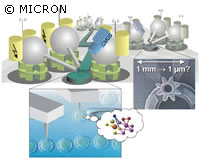EU project creates micro-robots
The MICRON (Miniaturised Co-operative Robots advancing towards the Nano range) project, funded under the information society technologies (IST) priority of the Sixth Framework Programme (FP6) has succeeded in developing a tiny robot with the ability to move, and work successfully in medical, micro-assembly and atomic force experiments. The team, led by researchers from the Institute for Process Control (IPR) in Karlsruhe, Germany, has built something normally associated with science-fiction, not science fact. The plan was to develop a series of robots: 'Our goal was to have five robots operational, but this couldn't be done in out three year timeframe owing to the extreme complexity of the task,' said IPR´s Jörg Seyfried. 'Each one would measure about 1.5cm by 3 cm,' he says. 'They were designed to be complete robots, with different kinds of actuators for gripping, cell manipulation, and so on. Each one would be wireless, with lots of electronics on board, and an infrared control system - rather like a TV remote, but two-way in this case. They would be able to cooperate together on a range of tasks.' The team needed to develop a series of new systems to support the project, 'One of these was the wireless powering system, the 'power floor', which allows the robot to get energy from its surroundings,' says Dr Seyfried. 'It uses a coil system to transmit the electricity through the air.' The robots would be controlled by a special positioning system, which would view them from 40 to 50 cm above. 'The robots are not that intelligent. They don't for example know where they are, although they know which direction they are moving in.' The positioning system could control several robots simultaneously. The single successfully built robot went on to perform in a series of tests. The experiments showed that 'cell injection is entirely feasible, as is the micro soldering. Robots with this sort of capability, and mobility, would be perfectly suited to lab work, such as the micro assembly of prototypes. Tasks such as cell injection could be performed on a mass scale.' The developments made under MICRON are now in the reporting and evaluation stage. Many of the technologies used here will be used again in the parallel I-Swarm project, which uses many of the same technologies. 'This will build on MICRON to produce robots with a 'swarm' intelligence - that is, with limited capabilities, but able to communicate with each other', said Dr Seyfried.
Countries
Germany



